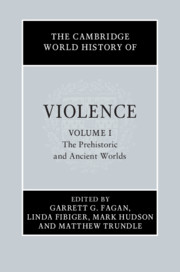Book contents
- The Cambridge World History of Violence
- The Cambridge History of Violence
- The Cambridge World History of Violence
- Copyright page
- Contents
- Figures
- Maps
- Contributors to Volume i
- General Introduction: Violence in World History
- Introduction to Volume I
- Part I The Origins of Conflict
- 1 The Origins of Warfare and Violence
- 2 Violence in Palaeolithic and Mesolithic Hunter-Gatherer Communities
- 3 Settled Lives, Unsettled Times: Neolithic Violence in Europe
- 4 Violence during the Later Stone Age of Southern Africa
- 5 Weapons, Warriors and Warfare in Bronze Age Europe
- 6 Weapons, Ritual and Warfare: Violence in Iron Age Europe
- 7 The Origins of Violence and Warfare in the Japanese Islands
- Part II Prehistoric and Ancient Warfare
- Part III Intimate and Collective Violence
- Part IV Religion, Ritual and Violence
- Part V Violence, Crime and the State
- Part VI Representations and Constructions of Violence
- Index
- References
3 - Settled Lives, Unsettled Times: Neolithic Violence in Europe
from Part I - The Origins of Conflict
Published online by Cambridge University Press: 13 March 2020
- The Cambridge World History of Violence
- The Cambridge History of Violence
- The Cambridge World History of Violence
- Copyright page
- Contents
- Figures
- Maps
- Contributors to Volume i
- General Introduction: Violence in World History
- Introduction to Volume I
- Part I The Origins of Conflict
- 1 The Origins of Warfare and Violence
- 2 Violence in Palaeolithic and Mesolithic Hunter-Gatherer Communities
- 3 Settled Lives, Unsettled Times: Neolithic Violence in Europe
- 4 Violence during the Later Stone Age of Southern Africa
- 5 Weapons, Warriors and Warfare in Bronze Age Europe
- 6 Weapons, Ritual and Warfare: Violence in Iron Age Europe
- 7 The Origins of Violence and Warfare in the Japanese Islands
- Part II Prehistoric and Ancient Warfare
- Part III Intimate and Collective Violence
- Part IV Religion, Ritual and Violence
- Part V Violence, Crime and the State
- Part VI Representations and Constructions of Violence
- Index
- References
Summary
The European Neolithic was a period of enormous social and economic changes affecting lifeways and population size, as well as beliefs and world views. By its closing stages in around 2500 BCE central and western European communities had been transformed from mobile or semi-mobile hunter-fisher-gatherer groups to settled populations reliant on farming and herding. The extent and significance of violence within and between communities during this period has long been debated, although attempts to resolve this issue have tended to generate more heat than light. However recent years have seen a growing corpus of evidence for violent assaults recognised among human remains from throughout Neolithic Europe. Viewed in aggregate, this line of evidence casts considerable doubt over notions of the period as a time of relative peace and stability. This chapter draws together the skeletal evidence for violence-related injuries from across Neolithic Europe and discusses these in terms of both overall prevalence and regional variation as well as the extent to which variations in demographic distribution are discernible. These patterns are considered in regard to the changing social contexts in which they occurred, with particular attention given to the role of population expansion, resource competition and the rise of social inequality. It is difficult to overestimate the importance of the Neolithic in the development of organised violence among human societies.
Keywords
- Type
- Chapter
- Information
- The Cambridge World History of Violence , pp. 79 - 98Publisher: Cambridge University PressPrint publication year: 2020
References
Bibliographic Essay
- 10
- Cited by

